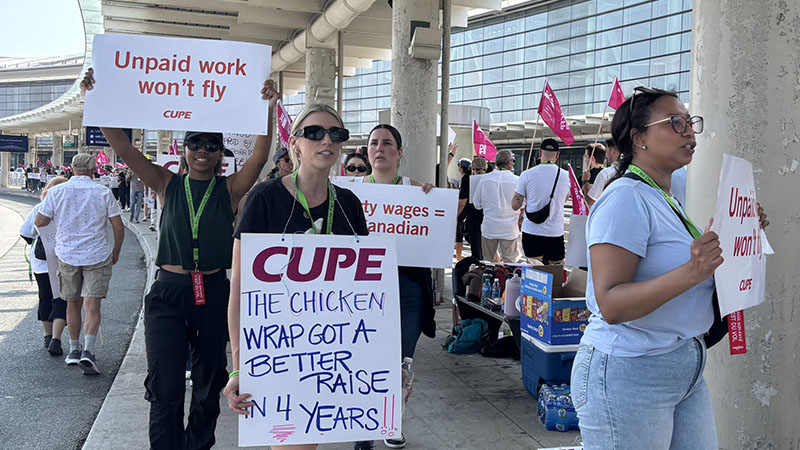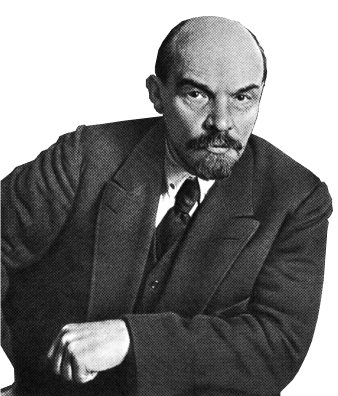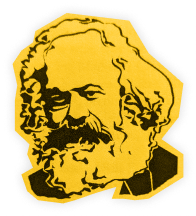
10,000 flight attendants did what no other union dared to do. They defied a back-to-work order and defeated it. This is a major defeat for the Carney Liberals who will not be able to violate trade union rights so easily in the future. But shocking many, the contract being proposed by the leadership maintains unpaid work and wages under the legal minimum.
How did we get here?
Historic defense of the right to strike
Violating the right to strike has become endemic in Canada. More and more, governments at both the provincial and the federal level have simply legislated the end to strikes that they have deemed too disruptive.
Normally, this would take the form of legislation proposed in the parliament (either federal or provincial) where the government would have to justify the violation of the right to strike and get enough votes to pass the legislation. This was the case in 2011 with the postal workers and Air Canada workers, in 2015 with CN rail workers and then in 2018 with the postal workers again.
But last year, the Trudeau Liberals found themselves in a bit of a pickle. They were in a minority government, propped up by the NDP—a party which most major unions are affiliated with. This is why they dusted off a rarely used obscure passage in the labour code: section 107.
Using this device, the government was able to put an end to a strike without a debate or vote in parliament! This also allowed the NDP to save face because they could continue to prop up the government without having to technically vote in favour of violating the right to strike.
All in all, the Trudeau Liberals used section 107 against seven different unions ending strikes of rail workers, postal workers and port workers.
But the result of this egregious violation of the right to strike has meant that employers have no reason to bargain in good faith. As Air Canada CEO Michael Rousseau confirmed in an interview with Bloomberg:
“We thought, obviously, that section 107 would be enforced.”
And he was right. Mark Carney continued the tradition and after only 12 hours of strike action, used section 107 to order the flight attendants back to work.’
Every single time this was used in the past the union leaders would buckle and order the workers back to work. This time, they defied the order and told the workers to stay on strike.
As the union correctly argued in a Facebook post:
“When laws protect billion-dollar profits over workers, defiance is necessary.”
As we have explained 1,000 times, at the end of the day the law is just a piece of paper. Real power is determined in the streets. And when the workers move, none of the oppressive laws stand a chance.
The significance of this cannot be overestimated. A massive step in the right direction has been taken. In taking this step, the flight attendants referenced the brave defiance of the Ontario education workers, who had also defeated back-to-work legislation in 2022. Now, every time the right to strike is violated, this courageous stand of the Air Canada flight attendants will show the clear path to follow.
Once the union defied the law, it was clear to anyone that if the government attempted to enforce their nonsense order with fines and arrests, they would have thrown gasoline on the fire.
So they chose a different method of putting an end to the strike.
Ending the strike
On Monday, the union leadership announced that Air Canada had reached out and they were headed back to the bargaining table.
In the wee hours of Tuesday morning, the union leadership announced that the strike was over and that a tentative agreement had been reached at the bargaining table. The initial reaction from almost everyone was jubilant. Multiple CUPE leaders like Candace Rennick (the National Secretary-Treasurer) stated that “UNPAID WORK IS OVER.”
However, since then details of the actual offer have come to light.
The first thing to note is that unpaid work is not over, not by a long shot.
Flight attendants will get 50 per cent of their hourly rate only for the first hour prior to take off. The majority of the unpaid time for other duties and layovers will remain unpaid. We must underline that this is exactly what was in the original offer before the strike. The only change is that this will rise to 70 per cent after four years.
Considering that Jobs Minister Patty Hajdu stated that unpaid work violated the labour code—and that they would be conducting an investigation into this—it is mind boggling that the union would accept anything less than 100 per cent pay for 100 per cent of time worked.
The other outstanding issue is wages. The initial offer according to the union was 17.2 per cent over four years. The union’s justification for rejecting this was, “even with the ‘best offer’ that Air Canada can make, entry-level Air Canada flight attendants working full-time will still earn less than federal minimum wage.”
In the new offer, wages for juniors will be increased a total of 20.26 per cent over the four year contract. While this is an increase and would not have been won without the strike, this still maintains wages for junior flight attendants below minimum wage.
For senior employees, the wage increase will be 16.26 per cent over the four year contract. These wage increases barely put a dent in the massive wage erosion that has occurred over the past 25 years, which has seen 69 per cent inflation while wages of flight attendants have only risen by 10 per cent.
The balance sheet of this struggle is contradictory. While defeating the back-to-work order is a historic step forward in the Canadian class struggle, the workers are now faced with a situation in which their leaders are recommending a deal that is not all that different from what was on the table before the strike. This is not what the workers fought for.
This did not have to happen
According to reports from flight attendants who attended the union’s Zoom meeting on Tuesday, the mood in the ranks is “depressed.” Some have expressed that they feel betrayed by the leaders.
This presents some valuable lessons that the trade union movement is having to learn the hard way. Negotiating should not be conducted in secret behind the backs of the members and then presented as a fait accompli after the troops have been taken off the battle field.
As this method of secret negotiations is all too common, workers should demand a rank-and-file committee be elected to sit in on the bargaining committee meetings to guard against bad back room deals. We must stand by the principle of open bargaining. The members have the right to know what is going on and the right to weigh in on all of the major decisions.
While the leaders claim that “we have defended our right to vote on the contract,” this doesn’t mean much. Indeed, when flight attendants asked in the online Zoom meeting if they would go back on strike if they voted the deal down, the leaders emphatically stated “no, absolutely not.” This is no genuine democracy. This is no genuine choice.
Unfortunately, many workers have gone through this experience. From the Vancouver port workers to the PSAC workers to the Ontario Education workers, it has become the norm for leaders to present a bad deal as a fait accompli—which the workers have no choice but to vote for.
It would therefore be unsurprising if a majority voted in favour of this deal—not because they are happy but because they see no other way forward.
We are at the beginning of a long process of the revival of the trade union movement in Canada. The rising anger from below is testing the old leadership which grew up in the age of relative class peace. In this process, leaders will be pushed into action or tossed aside and more militant leaders—ones who will genuinely fight for the interests of the workers—will come to the fore.
It is our task as revolutionaries to hasten this process along and help the widest layers of militant workers to learn the lessons from these events.
As we wrote in our Manifesto that we passed at our founding congress last year:
“Communism will find its way back to the mass of the working class and its organisations with these methods. Only a revolutionary leadership can rearm the workers’ movement as a fighting force.”
“The RCP aims to bring every layer of the working class into the struggle, whether unionised or not. We will be there, arm-in-arm with the workers in their day-to-day struggles everywhere, scraping and clawing for every gain that makes life more bearable under this rotten system. But what sets us apart is that at every stage, we will explain that the capitalist system is the root cause of the plight of the workers—that to defeat the attacks of the greedy bosses for good, the workers need to be the masters of society.”

